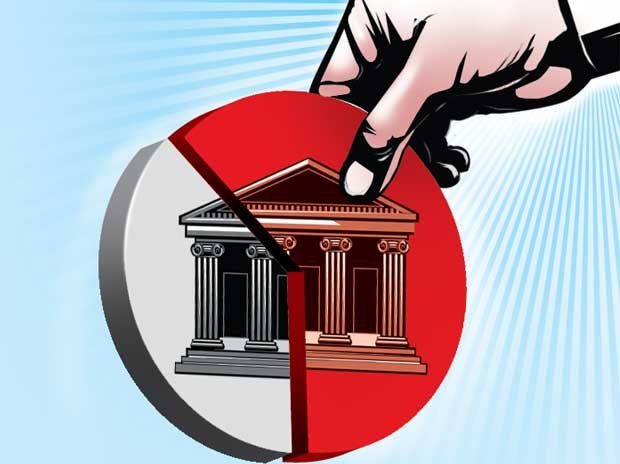Privatisation Of Banks In India

The Finance Minister Nirmala Sitharaman had last year decided to merge 10 public sector banks into four banks, thereby strengthening the infrastructure of the banks, so that they can meet international standards.
With the ‘merging’ just successfully implemented with the start of this financial year on April 1, the finance ministry now has plans to privatise some government-owned banks, in attempts to make them stronger.
Privatization of Government Banks
After a recent merger involving the amalgamation of 10 state-run lenders into four banks, the Niti Aayog, the policy think tank of the government had suggested last month to reduce the number of government-owned lenders to just five in number.
Currently, India homes 12 state-owned banks. The idea right now is to bring this number down to 4-5 government owned banks.
It is being recommended by several government committees as well as the RBI, to cut down the current 12 state-owned banks in India to not more than 5.
The plan is to sell majority stakes in:
Bank of India
Central Bank of India
Indian Overseas bank
UCO Bank
Bank of Maharashtra
Punjab & Sind Bank
A government official has reported that this privatisation proposal is being formulated by the government.
Objective behind this:
It is being reported that the main purpose behind this plan is to put a hold on future bailouts by using taxpayers’ money.
Until last month, there were alleged rumours of the government examining the possibility of privatising Punjab & Sind Bank, Bank of Maharashtra and Indian Overseas Bank.
In this ongoing privatisation plan, the government is trying its best to raise money by selling assets in non-core companies and sectors, at a time when there is a shortage of funds due to the Covid-19 outbreak.
When Can you Expect the Divestment Plans to Play Out?
As of now, the government is diligently working on creating a successful privatisation plan, which could boost funds.
Sadly, this plan is being worked out at such a bad timing, when banks are facing increasingly bad loans now and even in future, courtesy of the global pandemic.
Due to such unfavourable market conditions, the divestment plan may not take place this financial year. The bad loans situation may worsen (almost double) after the economy situation comes to a standstill.
The Indian banks already had loans amounting to 9.35 trillion, at the end of September 2019. Consequently, the government might need to put in about $20 billion into its state-owned banks.
With news gushing in from every direction and with perspective about the privatization of Public Sector Banks (PSBs) gaining more and more traction, everyone has viewpoint about what privatization could do to the banking sector, especially as when there’s public money involved.
So today, we will try to illuminate the current scenario of banking markets and why privatization could indeed be the saving spree for public sector banks, in today’s time.
Current Scenario of Banking Sector
Despite trying to maintain a stable stand amidst the strong current of the Covid-19 pandemic, the banking industry, particularly the PSBs are highly vulnerable to monetary and economic risks.
Now we would like to highlight the points which have arose due to the pandemic situation and the moratorium decisions.
According to the most recent Financial Stability Report by RBI,
- Under a baseline scenario the Gross Non-Performing Assets (NPA) of banks are anticipated to shoot up from 8.5% in March 2020 to 12.5% until March 2021.
- The numbers are worse considering severe stress scenario. The GNPA is expected to shoot up from 8.5% to 14.7%, for the same period.
Speaking of Public Sector Banks,
- The GNPA can shoot up from 11.3% to 15.2 per%, under the baseline scenario, from Mar 2020 to Mar 2021, while
- The same under the severe stress scenario could spur to 16.3% in the same period for severe stress scenario.
So, why is Privatisation Needed?
As per the finance ministry and RBI’s proposal, 51% of government’s stake in 6 PSBs will be cut in the next 12-18 months. Even though it seems hard to look at, privatising these banks has their own benefits. Having private ownership of banks will bring changes in structuring incentives and accountability.
This will give public banks the much needed push towards formulating more effective supervision and regulation, bringing into picture, a sense of market discipline.
Big economic events like demonetization and bank mergers brought a lot of uncertainty and changes with them.
Consequently, to pay off their gross NPAs, the banks have to drain in their profits. Due to events like these, the government is busy flooding in taxpayers’ money for the purpose of re-capitalisation, every now and then.
Then there is this global pandemic, which has brought all the economic activities to a standstill.
Due to this, there is no loan offtake, heightened security concerns, disruptions in supply chain and high fiscal imbalances resulting due to decreased revenues.
Even as the Indian banking industry remains stable amid a severe economic downturn, there is a crying need for reforms in the industry. The downward risk arising from the vulnerability of Scheduled Commercial Banks (SCBs), mostly the PSU banks, is worrisome, and needs to be addressed immediately, said a report by Brickwork Ratings.
The balance sheets of banks were already under severe stress before the pandemic hit. On top of that, the crisis created by the pandemic and moratorium offered is expected to deepen the hole in the banks’ pockets. In the latest RBI’s Financial Stability Report, the Gross NPAs of banks are projected to swell from 8.5 per cent in March 2020 to 12.5 per cent under a baseline scenario, and up to 14.7 per cent under a severe stress scenario by March 2021.
The projections for PSU banks are more pessimistic as the GNPAs may shoot from 11.3 per cent in March 2020 to 15.2 per cent under a baseline scenario and to 16.3 per cent under very severe stress scenario by March 2021.
In fact, the ratio of a bank’s capital to its risk, also known as Capital Adequacy Ratio (CAR), is estimated to deteriorate from 14.6 per cent in March 2020 to 13.3 per cent under a baseline scenario and to 11.8 per cent under a very severe stress scenario by March 2021.
The public sector banks have been busy fighting one emergency after another, be it demonetisation or mergers and they do not have any incentive to take risks and perform better as the government pumps in taxpayers’ money from time to time for recapitalisation, it further said.
Meanwhile, both- domestic and global factors are perceived to pose high risks. While the global risks arise from a protectionist tendency, security concerns, and supply chain disruptions, the domestic factors arise from the unprecedented economic crisis created by the coronavirus pandemic.
The intensity and duration of the pandemic remain unknown, and the discovery of the vaccine is still a work in progress. Heightened risks arise from a contraction in the GDP, high fiscal imbalances due to lower revenues, higher health expenditures are among major threats, the report added.
Finance Minister Nirmala Sitharaman on Thursday asked bankers to roll out loan resolution schemes by September 15 and COVID-19 related distress must not impact their assessment of borrowers' creditworthiness. She said lenders must immediately put in place board-approved policies for resolution, identifying eligible borrowers and reach out to them.















































